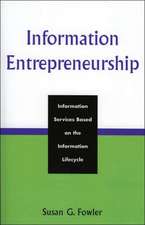Introduction to the Library and Information Professions
Autor Roger C. Greer, Robert J. Grover Professor Emeritus, Susan G. Fowleren Limba Engleză Paperback – 10 iun 2013 – vârsta până la 17 ani
Preț: 353.56 lei
Preț vechi: 518.20 lei
-32% Nou
Puncte Express: 530
Preț estimativ în valută:
67.66€ • 70.38$ • 55.86£
67.66€ • 70.38$ • 55.86£
Carte tipărită la comandă
Livrare economică 15-29 aprilie
Preluare comenzi: 021 569.72.76
Specificații
ISBN-13: 9781610691574
ISBN-10: 1610691571
Pagini: 216
Dimensiuni: 178 x 254 x 13 mm
Greutate: 0.41 kg
Ediția:Revizuită
Editura: Bloomsbury Publishing
Colecția Libraries Unlimited
Locul publicării:New York, United States
ISBN-10: 1610691571
Pagini: 216
Dimensiuni: 178 x 254 x 13 mm
Greutate: 0.41 kg
Ediția:Revizuită
Editura: Bloomsbury Publishing
Colecția Libraries Unlimited
Locul publicării:New York, United States
Caracteristici
Provides a current, detailed, and creative introduction to the library and information profession for students in LIS programs as well as practicing professionals seeking continuing education
Notă biografică
Roger C. Greer, MLS, PhD, is dean emeritus of the School of Library and Information Management at University of Southern California, former dean at Syracuse University, and professor emeritus at Emporia State University.Robert J. Grover, MLS, PhD, was associate vice president for academic affairs and dean of graduate studies at Emporia State University, where he had held the position of dean and professor of the School of Library and Information Management. Susan G. Fowler, MLS, teaches at Flint Hills Technical College in Emporia, KS, and remains active in the information consulting business she founded in 1993.
Cuprins
PrefaceChapter 1: Introduction: Purpose and Objectives of This BookChapter OverviewWhy Read This Book?The Intended AudienceScope of the BookThe Role of ProfessionalsThe Value of TheoryTheory in the Information Professions TodayTheory and Its Uses in Professional ServiceDefining TermsInformation and Communication Professions: Convergence and DivergencesSimilarities and Differences among the Information ProfessionsCharacteristics of a ProfessionLibrary Technicians and Library AssistantsConclusionReferencesChapter 2: Creation, Diffusion, and Utilization of KnowledgeChapter OverviewIntroductionInformation and DataKnowledgeCreation of KnowledgeDisseminationDiffusionUtilizationChange and the Evolution of ProfessionsA Model for Explaining the Creation, Diffusion, and Utilization of KnowledgeCreating New KnowledgeDiffusion of KnowledgePublic PolicyRole of Professions in the Utilization of KnowledgeImplications for Information ProfessionalsSummaryReferencesChapter 3: The Role of Professionals as Change AgentsThe Impact of Change on SocietyCategories of ChangeThe Paradigm Shift in Western SocietyThe Paradigm Shift in Disciplines and ProfessionsParadigm Shift in the Information ProfessionsLevels of User-Centered ServicesConclusionReferencesChapter 4: The Science Supporting the Information ProfessionsChapter OverviewThe Importance of Theory to ProfessionalsLevels of TheoryCharacteristics Common to the Information ProfessionsThe Science of the Information ProfessionsPolicy and Environmental ContextConclusionReferencesChapter 5: Information Transfer in the Information ProfessionsChapter OverviewIntroduction to Information TransferA Closer Look at Information TransferInformation Professions and Information TransferA Model for Managing an Information UtilityCommunity Information InfrastructureConclusionReferencesChapter 6: The Cycle of Professional ServiceChapter OverviewRole of the ProfessionalThe Diagnostic ProcessDiagnosing Information Use BehaviorsTheory Base for DiagnosisImplications for PractitionersThe Environmental ContextCommunity AnalysisPutting the Information to WorkConclusionReferencesChapter 7: The Information InfrastructureChapter OverviewDefinition of "Information Infrastructure"A Model for Studying the Information Infrastructure: The Transportation InfrastructureElements of the Information InfrastructureA Model for Analyzing the Information InfrastructureA Model for the Technology and Information InfrastructureRole of Information ProfessionalsConclusionReferencesChapter 8: The Processes and Functions of Information ProfessionalsChapter OverviewThe Importance of CustomizationThe Processes of Building a Collection of ResourcesThe Functions of Information AgenciesLevels of ServicePutting It All Together: The Role of the ProfessionalReferencesChapter 9: The Infrastructure of the Information ProfessionsChapter OverviewCharacteristics of a ProfessionHistoryBody of KnowledgeProfessional AssociationsLiterature of the FieldProfessional EducationAccreditationGuidelines for ServiceCode of EthicsPublic RecognitionTaxonomy of the Information ProfessionsConclusionChapter 10: Trends and IssuesChapter OverviewIntroduction Information Infrastructure IssuesIssues in Library/Information EducationRecent Studies in LIS EducationConclusionReferencesAppendix A: Codes of EthicsAppendix B: Professional OrganizationsAppendix C: Professional JournalsBibliographyIndex
Recenzii
This volume is well-written and delivers a compelling story about how the professions bring people and information together. It is recommended for public, community college, and university libraries.


























